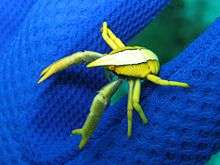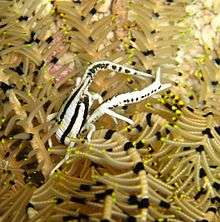Allogalathea elegans
Allogalathea elegans (known as the feather star squat lobster, crinoid squat lobster or elegant squat lobster) is a species of squat lobster that is sometimes kept in marine aquariums. Despite their common name, they are more closely related to hermit crabs than lobsters.[2]
| Allogalathea elegans | |
|---|---|
 | |
| Scientific classification | |
| Kingdom: | |
| Phylum: | |
| Subphylum: | |
| Class: | |
| Order: | |
| Family: | |
| Genus: | |
| Species: | A. elegans |
| Binomial name | |
| Allogalathea elegans (Adams & White, 1848) | |
| Synonyms [1] | |
| |
Description
Allogalathea elegans is bilaterally symmetrical.[3] The cephalothorax of Allogalathea elegans is droplet-shaped. The extremity of the body corresponds to the triangular rostrum of the animal, which are positioned on each side the pedunculated eyes. The rostrum is elongated and dorsally flattened and length varies. [4] They have between five and nine lateral teeth.[4] The chelipeds or the first pair of legs are endowed with pincers and are longer than the animal body. The last pair of legs are wasted. The body and mainly the legs are covered with small hairs. The animal's size depends on the sex. Females are usually bigger than males but never grow over 2 cm.[5] The animal's coloration is variable and is matching the colours of its host but not systematically.[6] It can be uniform and varied from dark red, blackish-purple, orange or brown. But generally, the observed animals have longitudinal stripes which the thickness, the number and the tint varies.[7]
Distribution
Allogalathea elegans lives in the tropical waters of the Indo-Pacific area, Red Sea included.[8] They can be found from the eastern coast of Africa to the Fiji Islands and from Japan to Southern Australia. [9] They have also recently been found in Korean waters.[10]
Habitat
Allogalathea elegans is a commensal species living in association with crinoids in which it gets protection and an ideal support for its feeding. They are capable of living outside its host, but its life expectancy will be shorter because it will not be shielded from predators.[11] They are generally found in shallow waters at depths between 0 and 146 m.[4]
Feeding
Allogalathea elegans are planktotrophic feeders.[3] They take advantage of their crinoid host who has the same diet and who always positions in the best catchment areas for the plankton to feed.[12]
Behavior
'Allogalathea elegans may be found living alone or in large aggregations together.[3] Many A. elegans have a symbiotic relationship with crinoids[9], most often feather sea stars[13]. These crinoids help protect them from their biggest predator, fish.[14] A. elegans are often found living close to or on top of crinoids.[15] When the need and opportunity to mate comes around, Allogalathea elegans participate in precopulatory rituals involving various sensory cues.[16]
Reproduction
Female Allogalathea elegans are multiple spawners that lay eggs that hatch into larvae.[17] Most females produced three or four broods during the annual reproductive period. [18] Reproductive females exhibit group-synchronous gonadal development as well as breeding synchrony. [17]
Development
Allogalathea elegans goes through four zoeal stages before reaching the megalopal stage and then into the juvenile and adult stages.[9] The duration of the four zoeal stages ranges from 13-16 days altogether.[9] Beginning at the megalopal stage, Allogalathea elegans look like smaller versions of the adult stage until they reach their adult stage.[3]
In aquaria
In an aquarium, A. elegans requires a water temperature of 77–79 °F (25–26 °C), a pH of 8.1–8.3 and a salinity of 1.020–1.024. Small crevices in rocks act as hiding places for this shy crustacean. A. elegans prefers thawed food but will also eat small freeze-dried items.[11]
References
- Gary C. B. Poore & Enrique Macpherson (2009). "Allogalathea elegans (Adams & White, 1848)". World Register of Marine Species. Retrieved April 8, 2010.
- Barret, John (October 7, 2014). "Squat lobsters: colorful kings of the ocean floor". Smithsonian Insider. Retrieved April 5, 2020.
- Poore, Gary C.B.; Taylor, Joanne; Ahyong, Shane T. (2011). The Biology of Squat Lobsters. Australia: CSIRO. ISBN 978-1-4398-6614-6.
- Cabezas, Patricia; Macpherson, Enrique; Machordom, Annie (June 2011). "Allogalathea (Decapoda: Galatheidae): A Monospecific Genus of Squat Lobster?". Zoological Journal of the Linnean Society. 162 (2): 245–270. doi:10.1111/j.1096-3642.2010.00681.x.
- "Galathée des comatules: Allogalathea elegans | (Adams & White, 1848)". Données d'Observations pour la Reconnaissance et l'Identification de la faune et la flore Subaquatiques {DORIS} [Observation Data for the Recognition and Identification of Underwater Fauna and Flora] (in French).
- Ferrari, Antonella & Andrea (2003). Underwater Malaysia Macrolife. Nautilus Publishing. p. 174. ISBN 9832731003.
- "Elegant Squat Lobster: Allogalathea elegans (Adams, A & A. White 1848)". Encyclopedia of Life. Retrieved April 5, 2020.
- "Allogalathea elegans (Adams & White, 1848)". BiotaTaiwanica. Archived from the original on December 12, 2013. Retrieved May 10, 2013.
- Fujita, Yosjihisa (November 2010). "Larval stages of the crinoid-associated squat lobster, Allogalathea elegans (Adams & White, 1848) (Decapoda: Anomura: Galatheidae) described from laboratory-reared material". Crustacean Research. 39: 37–53. doi:10.18353/crustacea.39.0_37.
- Lee SH, Lee SK, Kim SH, Kim W (2019). "First records of two squat lobsters (Decapoda, Galatheidae) from Korea". Crustaceana. 92 (6): 725–237. doi:10.1163/15685403-00003900.
- "Crinoid Squat Lobster". LiveAquaria.
- Coleman, Neville (2011). Marine life of the Maldives. Atolls Editions. p. 214. ISBN 187641054X.
- "Elegant Squat Lobster". WhatsThatFish. Retrieved April 5, 2020.
- "Are squat lobsters really lobsters?". Ocean Exploration and Research. Retrieved April 5, 2020.
- Ahyong, Shane (2007). "Decapod Crustacea collected by the NORFANZ Expedition: Galatheidae and Polychelidae". Zootaxa. 1593: 1–54. doi:10.5281/zenodo.178624.
- Baba, Keiji; Macpherson, Enrique; Poore, Gary C. B.; Ahyong, Shane T.; Bermudez, Adriana; Cabezas, Patricia; Lin, Chia-Wei; Nizinski, Martha; Rodrigues, Celso; Schnabel, Kareen E. (October 15, 2008). "Catalogue of squat lobsters of the world (Crustacea: Decapoda: Anomura (families Chirostylidae, Galatheidae and Kiwaidae)". Zootaxa. 1905 (1): 1–220. doi:10.11646/zootaxa.1905.1.1. ISSN 1175-5334.
- Flores, Andres; Brown, Donald I.; Queirolo, Dante; Ahumada, Mauricio (May 2020). "Gonadal development of female red squat lobsters (Pleuroncodes monodon H Milne Edwards, 1837)". Fisheries Research. 225. 105508. doi:10.1016/j.fishres.2020.105508.
- Thiel, Martin; Espinoza-Fuenzalida, Nuxia. L; Acuna, Enzo; Rivadeneira, Marcelo M. (January 3, 2012). "Annual brood number and breeding periodicity of squat lobsters (Decapoda: Anomura: Galatheidae) from the continental shelf of the SE Pacific—Implications for fisheries management". Fisheries Research. 129-130: 28–37. doi:10.1016/j.fishres.2012.06.004.
External links

- Photos of Allogalathea elegans on Sealife Collection
